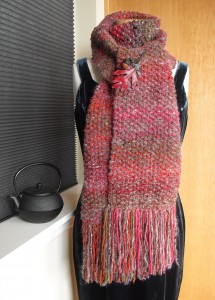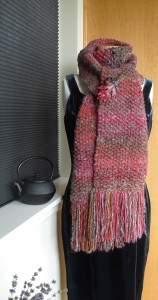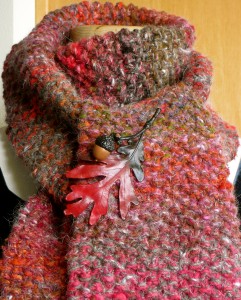Everything about this scarf is scrumptious! The yarn, the colors, the softness, the easy to execute pattern, the design, how warm and thick it is and how finally how elegant it looks! I love the name too! I think the stitch pattern is sometimes referred to as the blackberry stitch, but the Noro book doesn’t explain that. Anyway, it was easy to make. I am often working on really difficult knitting projects in which I have to concentrate closely on every stitch and row I make. This was a good break being a repetitive easy to do and remember pattern that I could work on while talking to people, watching a film, waiting for an appointment, etc.
Because I was only knitting with two types of yarn it was also an easy to carry around project! I need to take on more like this. It is hard to lug around a basket of 50 different colors and types of yarns when I want to knit away from home. All serious knitters usually have several different kinds of projects on needles and in the works at any given time. Of late I have been finishing a lot of things and don’t have something easy that I gan grab as I leave the house and work on when I get a chance while out. It is time to set up another one.
The Blackberry is another pattern from the book Naturally Noro by Jane Ellison using Noro’s yarns. This is actually a booklet, rather than a book. It looks like a magazine. As far as I know these are not available from bookstores. I believe they are only sold by specialty yarn shops that also carry Noro’s yarns.
The yarns specified and the ones I actually used are Noro’s Iro in shade 9 and Noro’s Kochoran in shade 17. You work with one strand of each type, held together throughout the entire project. It is also done on giant size #13 US knitting needles so it knits up really quickly. That means instant gratification! I used Clover bamboo needles.
I have experimented with many types of needles and these are my favorites. I have found that stitches and the finished fabrics actually look very different knit on needles made of different materials. I recommend using the same type of needles made by the same company of the same material for your entire project.
I once made a pair of gloves on size 7 wooden needles. I had a pair of Clover and a pair of Brittany – both wood, both size 7. I wanted to make both gloves at the same time. I launched into the knitting. Unfortunately both gloves looked different! They were knit of the same yarn in the same technique, by the same person. The difference came from the two brands of needles made of the same type of wood. I showed them to many people at my local knit shop. They could all tell there was a pronounced difference. Caused by using two different brands of wooden needles in the same size! The one knit on Clover needles looked the smoothest. So I ripped out the other one and reknit the entire glove to match the better looking one done on the Clovers. A tough lesson learned the hard way! You don”t have to go through that because I am warning you ahead!
This finished scarf is 96 inches long. It is mighty long and mighty thick and I love it that way! It’s very warm! Mighty warm! It also has fabulous fringe on both ends! I also love fringe! It is so dramatic! I love tossing it! This scarf is so long and big and thick that is is almost like wearing a coat! It does it’s job as a winter scarf! I also like having all the warm thickness of several layers of it cuddled up around my neck.
Noro’s yarn is hand dyed and hand spun in small batches in Japan! When they come out with a color it is usually not available very long. In fact I have had a lot of trouble actually getting enough of it in the same type and color to make entire sweaters – even size small women’s sweaters and children’s sweaters which is what I am usually making!
Noro, himself, is a painter who became a knitter and spinner. Working with his yarns is like painting. They are spectacular! To me at least. I actually like the immense amount of variation in each skein and the difficult to get enough of it aspect. I like the uneven spinning and unpredictable differences found in each small batch because It is like painting. I approach knitting with it like painting and I am willing to experiment and work with it’s unique qualities to achieve the effects I want. Incidentally these are unpredictable and they evolve as you work with the yarn. They cannot be planned in advance. There is an element of chance involved. I like that in my knitting. Even though I am a technical perfectionist! In the end, when I have finished knitting a garment out of Noro’s yarn I know I have a unique to me one of a kind piece!

The Fabulous Blackberry Scarf Designed by Jane Ellison & Knitted by Lady Violette with Yarns by Noro
Now I am all excited and I want to go buy yarn and start another one! I am worried about what may happen to Noro yarn given the Tsunami disaster in Japan. Of course I am more worried about other things in Japan, but the Noro yarns are definitely important elements in my work! They have always been hard to get and I am concerned that their availability may be seriously impacted. I am going to investigate this.
The oak leaf pin with an acorn looks like it is made of copper, then enameled. It is a vintage piece that I found at the Goodwill! It is a perfect accent on this scarf!
People often ask me how much it costs to make something like this. The kinds of yarns I use are luxury yarns of natural fibers. In the case of Noro all the steps of production are done organically. All of them! From raising the sheep to getting the ball of yarn onto a shop’s shelf! The fibers used are the best available and often rare. Consequently, Noro’s yarns are very expensive. These are $20.25 per skein and the sweater required 6 skeins total! So the yarn cost was $121.50 before tax, The pattern book is $24 and you will also need a pair of Clover bamboo or similar wooden knitting needles in size 13US which are about $10. Allowing for a few other miscellaneous supplies and tax the project cost comes to about $170 just for the materials.
That is the cost to make this sweater if you knit it yourself! No allowance is figured in for the amount of time and expertise for an expert knitter to make if for you! I am often asked why I do not sell the beautiful hand knits that I make on eBay or Etsy. It would not be worth it for me to do so. The honest truth is that people are not willing to pay what it costs to make them! Or to pay me anything for my time to make them! I have friends who knit and sell their work that way and I have watched the process. They make wonderful things but cannot charge enough to even cover the cost of using top quality yarns. I have had many discussions with fiber artists sharing their experiences selling in these venues. If they continue to do so they knit items in acrylic yarn and make only uncomplicated things that they can produce quickly. The online buying public is not willing to pay for hand knits in particular. Too few people who do not knit themselves understand what is involved and are, thus, unwilling to pay for it.
I have sold on eBay and Bonanza and I know how these systems work. It usually isn’t worth the effort involved. I have written an article about selling on eBay which I will intend post on my blog soon. I am quite willing to share what I have learned about that! I sold high end high quality vintage clothing on eBay for over a year. It was difficult and not worth the effort involved! More about that later!
The bottom line is that, if you want a really gorgeous hand knitted scarf like this one you will have to knit it yourself or find a friend who will do it for you. Or, better yet, teach you to knit! And that is a good thing as you will have the enjoyment of the knitting process for your time investment as well! Knitting is a wonderful fulfilling meditative calming, and grounding experience.
I honestly hope seeing this Blackberry scarf and the other projects I have posted inspires you to knit!
As far as I am concerned that is the big picture! This is the softest, warmest winter scarf I own! The easy pattern is appropriate for a beginning knitter who knows how to knit, purl, cast on and off, and can read a basic pattern.
Scarves are worn in every culture and knitting is done all over the world. Every country has techniques and styles to contribute to the great knitting, scarf design and styling repertoires available for us to draw from. Interestingly the Blackberry is truly an International Scarf because the yarn is from Japan, the designer, Jane Ellison is British and it was knitted in the United States by Lady Violette! I find this crossover of influences fascinating and it adds interest to the scarf for me!












